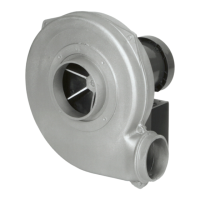Before Connecting Power
1. Inspect all fasteners and retighten if necessary:
a. Foundation bolts.
b. Set screws in fan and wheel and V-belt drive
(See Tables #1 & #2 on preceding page).
c. Housing, bearing and motor mounting.
2. Any inspection doors should be tight and sealed.
3. Bearings should be checked for alignment and
lubrication (See Bearing Maintenance, pages 4 & 5).
4. Turn rotating assembly by hand to insure that it does
not strike housing. If the wheel strikes the housing,
the wheel may have moved on the shaft or the
bearings may have shifted in transit. Correction
must
be made prior to start up.
5. Check motor to insure proper speed and electrical
characteristics.
6. Check V-belt drive for alignment and correct belt
tension.
7. After wiring, energize motor for one second to check
for proper rotation.
The key to good fan maintenance is a regular and
systematic inspection of all fan parts. Severity of the
application should determine frequency of inspection.
The components requiring service are generally the
moving parts which include bearings, fan wheel, belts,
sheaves and motor.
Cast Aluminum & Metal Parts
Cast aluminum and steel parts usually do not require
maintenance during the life of the unit except painted
metal surfaces that may require periodic repainting. In a
severe, dirty operation, the wheel should be cleaned
with a wire brush to prevent an accumulation of foreign
matter that could result in fan unbalance. After cleaning
wheel, inspect for possible cracks or excessive wear,
which can cause unbalance. DO NOT operate a wheel
that is cracked, chipped, has broken blades or excessive
wear. NOTE: If wheel set screws are loosened and/or
wheel is removed from shaft, set screws must be
replaced. Set screws cannot be used more than once.
Belts on V-belt drive units require periodic inspection
and replacement when worn. For multiple belt drives,
belts should be replaced with matched sets.
Motor Maintenance
1. Disconnect or lock out power to motor.
2. Removing dust and dirt: Blow out open type motor
windings with low pressure air to remove dust or dirt.
Air pressure above 50 P.S.I. should not be used as
high pressure may damage insulation and blow dirt
under loosened tape. Dust accumulation can cause
excessive insulation temperatures.
3. Lubrication: The motor bearings and the fan bearings
on the belt drive fans should be greased at regular
intervals. Motor manufacturers’ greasing instructions
and recommendations should be followed closely.
Avoid the use of a pressure greasing system which
tends to fill the bearing chamber completely. Do not
overgrease. Use only 1 or 2 shots with a hand gun in
most cases. Maximum hand gun rating 40 P.S.I.
Rotate bearings during lubrication where good safety
practice permits.
NOTE: On motors with non-regreasable, sealed
bearings, no lubrication is required for the life of the
bearings.
To prevent rusting of bearing parts, the motor shaft must
be rotated at regular intervals (30 days) to assure these
parts are well covered with oil or grease.
3
VI. GENERAL MAINTENANCE
Before any maintenance or service is performed,
assure that unit is disconnected or locked out from
power source to prevent accidental starting.
CAUTION
A WORD OF CAUTION
ABOUT MOTORS
Using your hand to test the running temperature of
a motor can be a very painful experience:
Normal body temperature ..........................98.6° F
Threshold of pain caused by heat............120.0° F
Average temperature of hot tap water......140.0° F
Average temperature of hot coffee...........180.0° F
Normal operating temperature of a
fully loaded electric motor open type,
70° F ambient temperature .....................174.0° F
V. OPERATION

